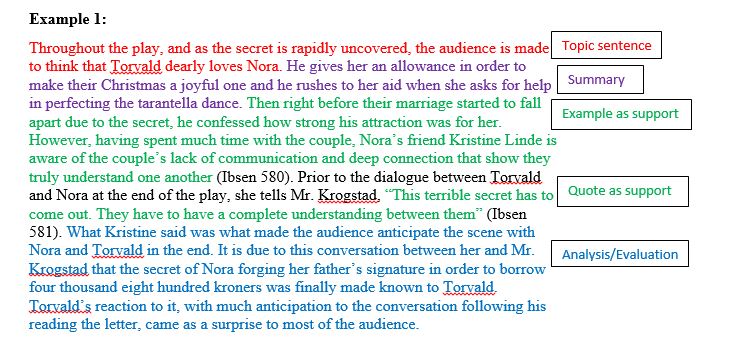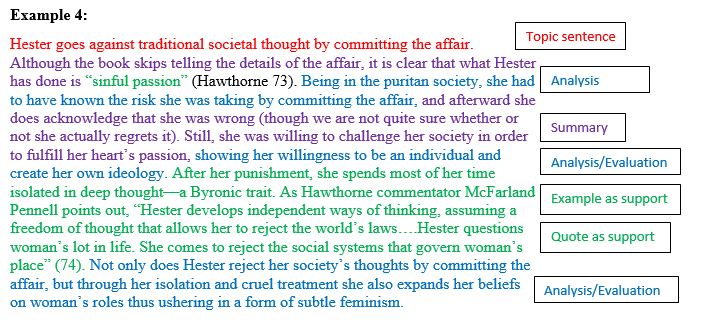22 Using Quotes, Paraphrases, and Summaries
This chapter will discuss using and integrating sources into your essay to support your ideas. This is one of the most important parts of the writing process, because the sources “support” and “prove” your claims. Remember the 80% rule, though–at least 80% of your writing should be your own words!
Integrating Sources
Your goal within a research paper is to integrate other sources smoothly into your paper to support the points you are making. As long as you give proper credit, you can ethically reference anyone else’s work. You should not, however, create a paper that is made up of one reference after another without any of your input. You should also avoid using half-page or whole-page quotations. Make sure to write enough of your material so that your sources are integrated into your work rather than making up the bulk of your paper.
Think of yourself as a kind of museum docent or tour guide when you are integrating sources into your work. You’ll usually want to take some time to set up your use of a source by placing it in a proper context. That’s why in most cases, before you even launch into quotation, paraphrase, or summary, you will have probably already used what’s called a “signal phrase” that identifies the author of the source, and often the specific publication (whether web or print) from which it is taken. After your use of the source, you’ll need to follow up with analysis and commentary on how you think it fits into the larger context of your argument.
Quotes
Quotes involve the following:
- Introducing the quote
- Taking a source word-for-word, putting it in your paper, and using quotation marks.
- Citing the source correctly in the documentation style you are using for your paper.
- Wrapping up the quote with your own words in a way that clearly shows readers how the quote is related to your argument.
Paraphrases and summaries
Paraphrases involve the following:
- Taking details from a source and putting them in your own words.
- Must be cited correctly.
- No page number needed.
Summaries involve the following:
- Taking the main idea of a source and summarizing it in your own words.
- Must be cited correctly.
- No page number needed.
Paraphrased and summarized text is cited within text in the same way that quoted material is cited except that quotations are not used.
Properly Summarizing and Paraphrasing
When you summarize, you should write in your own words and the result should be substantially shorter than the original text. In addition, the sentence structure should be your original format. In other words, you should not take a sentence and replace core words with synonyms.
You should also use your words when you paraphrase. Paraphrasing should also involve your own sentence structure. Paraphrasing might, however, be as long or even longer than the original text. When you paraphrase, you should include, in your words, all the ideas from the original text in the same order as in the original text. You should not insert any of your ideas.
Both summaries and paraphrases should maintain the original author’s intent and slant. Taking details out of context to suit your purposes is not ethical since it does not honor the original author’s ideas.
Study the examples in the following table for clarification between summarizing, paraphrasing, quoting, and plagiarizing.
| Original text | Some dramatic differences were obvious between online and face-to-face classrooms. For example, 73 percent of the students responded that they felt like they knew their face-to-face classmates, but only 35 percent of the subjects felt they knew their online classmates. In regards to having personal discussion with classmates, 83 percent of the subjects had such discussions in face-to-face classes, but only 32 percent in online classes. Only 52 percent of subjects said they remembered people from their online classes, whereas 94 percent remembered people from their face-to-face classes. Similarly, liking to do group projects differs from 52 percent (face-to-face) to 22 percent (online) and viewing classes as friendly, connected groups differs from 73 percent (face-to-face) to 52 percent (online). These results show that students generally feel less connected in online classes. |
| Summarized text | Students report a more personal connection to students in face-to-face classes than in online classes. |
| Paraphrased text | Study results show a clear difference between online and face-to-face classrooms. About twice as many students indicated they knew their classmates in face-to-face classes than in online classes. Students in face-to-face classes were about two-and-a-half times more likely to have discussions with classmates than were students in online classes. Students in face-to-face classes were about twice as likely to remember classmates as were students in online classes. Students in face-to-face classes viewed group projects as positive about two-and-a-half times more often than did students in online classes. Students in face-to-face classes saw class as a friendly place 73 percent of the time compared to 52 percent for online classes. Summing up these results, it is clear that students feel more connected in face-to-face classes than in online classes. |
| Quoted text | The study showed that personal discussions are much more likely to take place in face-to-face classes than in online classes since “83 percent of the subjects had such discussions in face-to-face classes, but only 32 percent in online classes.” |
| Plagiarized text | Some major differences were clear between Internet and in-person classrooms. For example, 73 percent of the study participants felt they were acquainted with their in-person classmates, but only 35 percent of the participants indicated they knew their distance classmates. |
Exercise 1
1. Consider these two sentences:
- The KOA system is a large camping organization in the United States.
- KOA campers and staff take part in many public service activities.
Explain whether each of these statements is common knowledge or proprietary and why.
2. Online, find a source on a topic of interest to you. Copy a paragraph from the source. Then, complete the following:
- Summarize the paragraph.
- Paraphrase the paragraph.
- Write a paragraph about the passage that includes a direct quotation from it.
Integrating Summaries, Paraphrases, and Quotes Within Paragraphs
Below are some examples of the various ways paragraphs can be organized. You’ll see that all paragraphs have a topic sentence. After this you may include summaries, paraphrases, or quotes from your sources, along with your own commentary or analysis on the topic.




Example 5:

Exercise 2
1. Look at one specific paragraph in your essay rough draft. Using colored pens, mark what each sentence is (topic sentence, paraphrase, summary, support, argument, etc…). If your paragraph is lacking source support, work on integrating it as demonstrated above.
Correctly Citing Sources
Citing sources is critical since you do not want to be guilty of stealing ideas from others, and using others’ intellectual property without giving them credit is, indeed, a form of stealing. A bonus that comes with citing sources is that aligning others’ ideas with your ideas adds credibility to your ideas and helps establish your ethos. Also, when you address more than one viewpoint, you strengthen your viewpoint.
In order to know exactly how you should cite sources, you need to know the reference style you will be using. Regardless of which citation style you use, you should follow the following general guidelines:
- Enclose all direct quotations in quotation marks and cite the source within the text, including page number, author, and year (if your style requires all these parts) so it is very clear where you acquired the information.
- When you summarize or paraphrase text, do not use quotations, but note the author and year (or other required information depending on the citation style) either as part of the sentence or in parentheses following the sentence to clearly note that the ideas belong to someone else.
- At the end of your paper, include a complete list of references, each properly cited using the required citation style.
Additional Resources:
Quoting, paraphrasing, and summarizing sources:
Attributions
- “Making Ethical and Effective Choices” licensed CC BY NC SA 3.0.
- “Chapter 22” licensed CC BY NC SA 3.0.
- Content adapted from The Worry Free Writer and licensed under CC BY NC SA.
- Content created by Dr. Sandi Van Lieu and and licensed under CC BY NC SA.
